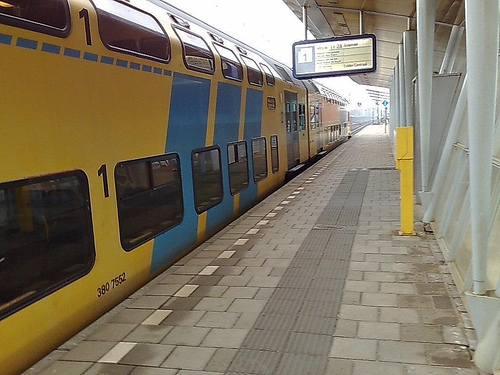 This morning, I am typing this on a bench at a train station while I am waiting for my connection. I have a place where I want to go, but there are no straight trains to get there, nor has getting there been fundamentally changed over the past fifty years. Or even longer. Let’s face it, the last great boost in technology for public transport came when we traded steam for electricity or diesel for areas where they couldn’t be bothered to put the wiring in. And in the meantime, we are sitting in traffic jams with all their negative side effects. Something is wrong here.
This morning, I am typing this on a bench at a train station while I am waiting for my connection. I have a place where I want to go, but there are no straight trains to get there, nor has getting there been fundamentally changed over the past fifty years. Or even longer. Let’s face it, the last great boost in technology for public transport came when we traded steam for electricity or diesel for areas where they couldn’t be bothered to put the wiring in. And in the meantime, we are sitting in traffic jams with all their negative side effects. Something is wrong here.
I know I am probably not the first one to say this, but where are the personal transportation pods? The Netherlands is reasonably covered in rails. Trains go to most of the country, and there are many well situated stations. But very often our train journey takes us along the route of the majority rather than suiting our personal needs. A transportation pod could solve a problem here. Today I am traveling from my home to a city about an hour and fifteen minutes away by car. The journey will take two hours by train. Most of that extra time is taken up by waiting to change trains. So what if we would change all of that?
Imagine I wake up in the morning and I decide where I need to go. The new train system allows me new choices. I choose to travel to my destination in a standard transportation pod. It is a small unit that can hold four people and their luggage that can be pre-reserved or taken from a station based on availability. The fare you pay depends on the way you book your pod. If you pre-reserve, you get immediate availability in a timeframe of 15 minutes around your chosen departure time. And you get a small discount on your trip. You also pay a pod price, that can be shared with your passengers by swiping a card or NFC enabled device within the pod. That way it will become cheaper and easier to provide group transportation for companies or for a day out with the family. The pod then runs along the rails of the train network at high speeds, being constantly guided by a local and central computer system. This takes you to your destination in almost the time as it takes to take your car. A good start.
Now look at it from a business perspective. It offers traditional train travellers the experience they are used to, but without the smelly neighbour. It also offers drivers the individual transport that they claim is their main reason to stand in traffic jams. You can offer multiple sized pods with four seats being the standard and other sizes designed to suit needs. A two seater pod for romantic outings or a twelve seater pod with alternative seating arrangements for meetings on the road. Hooligan pods that have nothing destructable in them, or festival pods that offer a place to pre-party with groups. And all these pods can be priced differently based on the needs of the client, subscriptions, time of day, distance and many other factors. And you can even decide on running very large pods, just like a current train, on busy routes at busy times offering travellers a significant discount for traveling in a group.
Are there no challenges? Yes, there are. Pod availability at stations will be a problem. However, travellers often wait fifteen minutes to get on their train now. Central storage locations at a maximum of fifteen minutes from a station could solve the availability problem for travellers that did not register a pod. However, special pods can only be reserved beforehand. A technical problem is the issue of passing at stations. At smaller stations there might only be two rails available allowing two way traffic. Another ‘parking rail’ ought to be installed so that passengers can easily get in and out of pods without stopping other traffic. And then there is the issue of level crossings. Personal transportation pods might be keeping the booms of the level crossing closed all the time due to their number and irregular schedules. From a business point of view, the biggest trouble lies in the investment. Individual transportation pods need to be built, old trains need to be scrapped and contracts to build new trains need to be cancelled. But the transition does not need to take much time. You can even allow for a bathroom or coffee break button in a pod, allowing new business at stations. And you could think of a million things you can do with a pod on the road when connected to wifi and social networks.
I honestly believe the individual transportation pod on rails has a future. But it’s main advantage is it’s main disadvantage. It is new and disrupts a business model public transportation firms have been using for decades. And obviously there will be problems I haven’t even considered. But I am sure there are ways to solve them without breaking the bank.

 I love the future. I have loved it ever since I started reading. Technology is shaping our future fast. Back in 1985 I wrote my first computer program. Back in 1994 I launched my first website and I have been working with organizations on integrating new technology ever since.
I love the future. I have loved it ever since I started reading. Technology is shaping our future fast. Back in 1985 I wrote my first computer program. Back in 1994 I launched my first website and I have been working with organizations on integrating new technology ever since.
Leave a Reply